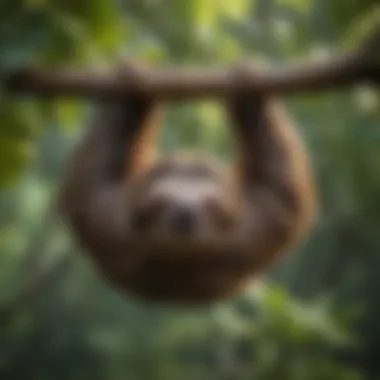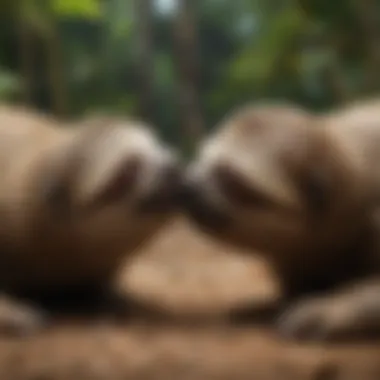Examining Sloths: Are They Dangerous to Humans?


Intro
The relationship between humans and wildlife can be a fascinating yet complex interplay. When considering sloths, these three-toed tree-dwelling mammals, the perception is often one of harmlessness. However, one may ask: Are these seemingly innocuous creatures more dangerous than they appear? This article serves as a thoughtful exploration of the potential risks associated with sloths from a biological, behavioral, and ecological standpoint.
Understanding sloths requires digging into the nuances of their existence. There’s more to them than their slow-paced lifestyle and cute appearance. By examining their evolutionary makeup, social behaviors, and ecological roles, we unveil a broader picture that highlights both their charm and risks.
As we traverse through their habitats in the dense jungles, we will also contemplate the implications these creatures hold for human interactions. This narrative extends beyond mere curiosity; it’s crucial for wildlife enthusiasts, educators, and conservationists to grasp the multi-faceted dynamics that affect how sloths and humans coexist.
Through a comprehensive analysis, we will seek to clarify whether sloths indeed pose any risks to humans and the environment. Let’s begin with an overview of these unique animals.
Understanding Sloths
To grasp the potential risks posed by sloths to humans, it’s crucial to first understand these unique creatures. The term "sloth" often conjures images of laziness and a carefree existence. However, there’s much more beneath the surface, and appreciating their biology, behavior, and ecological roles allows for a more nuanced perspective.
Learning about sloths isn’t merely about their slow movements; it involves delving into their adaptive features, habitat needs, and inter-species interactions. Engaging with this information lays the groundwork for evaluating any dangers they might present to human safety. Knowledge empowers not just wildlife enthusiasts but also educators and students making it essential to underscore the importance of this topic.
Taxonomy and Species Diversity
Sloths belong to the order Pilosa, primarily divided into two families: Megalonychidae and Bradypodidae. The former includes the two-toed sloth, such as the Linnaeus's two-toed sloth, while the latter consists of the three-toed sloths, like the Brown-throated sloth. Each species exhibits distinct behavioral traits and adaptations, influencing their interactions with the environment and humans. For instance, the Pygmy three-toed sloth, one of the rarest species, is found only in a specific region of Panama and highlights the delicate balance of their ecosystems.
By studying taxonomy, individuals can appreciate the diverse adaptations that sloths have developed in response to their habitats, which ultimately affect the dynamics of their relationship with humans.
Habitat and Distribution
Sloths are predominantly found in Central and South America, inhabiting tropical rainforests, cloud forests, and mangroves. Their arboreal lifestyle provides both shelter and food sources, crucial for their survival. Dense vegetation allows them to camouflage effectively from predators, an interesting fact that may seem less relevant when discussing the potential danger to humans.
Sadly, habitat loss due to deforestation severely impacts sloths. When their environment is threatened, sloths may venture into human-occupied areas, inadvertently increasing the likelihood of encounters.
Common habitats include:
- Amazon Rainforest
- Atlantic Forest
- Central American Cloud Forests
Understanding the distribution and habitat preferences of sloths is essential for evaluating potential risks during those unexpected encounters.
Physical Characteristics
Their slow metabolism and unique physical features contribute to sloths' distinctive lifestyles. Sloths are equipped with long claws that allow them to grip tree branches securely. This enables them to traverse their arboreal habitats at a leisurely pace, but it also influences their interaction with people.
Notably, the strong yet long claws can cause damage if a sloth feels threatened, as their natural defense mechanism kicks in. The physical robustness of a sloth can be surprising to those who perceive them merely as cute and cuddly creatures. Additionally, their fur hosts various ecosystems that can harbor parasites, which can transmit diseases to humans, a lesser-known risk that merits attention.
"Understanding sloths not only highlights their unique characteristics but also allows for a greater awareness of interactions that could pose risks to humans."
Behavioral Traits of Sloths
Understanding the behavioral traits of sloths is essential for grasping their role in their environments and their interactions with humans. While these creatures are predominantly known for their slow pace and seemingly lethargic lifestyle, there lies a complex array of behaviors that serve vital functions for their survival. Learning about the traits of sloths sheds light on the nuances of their biology and informs our perceptions about their potential risks to humans. In this section, we will dive into several key aspects: their diet and foraging habits, social structures, and their interactions with predators, each of which plays a significant part in the overall understanding of sloths.
Diet and Foraging Habits


Sloths are herbivores, primarily feasting on a diet consisting of leaves, fruits, and flowers. Their foraging habits reveal a lot about their efficiency as opportunistic feeders. One fascinating aspect is their incredibly slow metabolism; these animals can take up to a month to digest a single meal. This slow digesting process is a double-edged sword. On one hand, it allows sloths to thrive on low-nutritional food sources, such as tough leaves from trees like the Cecropia or the Piptadenia.
- The sloth’s infamous lethargy aids in energy conservation, as movement requires significant energy.
- They possess an impressive ability to extract moisture and nutrients from their food, thus reducing their dependency on direct water sources.
- When foraging, sloths often stay in the same tree for long periods, which can expose them to potential predators.
This behavior is important to consider, as it presents a possible hazard if humans unknowingly cross paths while the sloth is trying to forage.
Social Structures
Sloths are not typically known for forming complex social structures. Most species lead solitary lives, occasionally coming together during the mating season. Even then, interactions tend to be brief and primarily centered around reproduction.
- Communication among sloths is minimal; their primary vocalizations consist of low grunts, moans, and soft whines, mainly communicating with mothers and offspring.
- Young sloths stay with their mothers for up to two years, learning critical survival skills before venturing out on their own.
This solitary nature may seem harmless, but it underscores an aspect of their vulnerability. When they engage with humans, their instinctual wariness can make them defensive. Understanding this can help reduce unintended human-animal conflicts.
Interaction with Predators
Although sloths have few natural predators, mainly jaguars, ocelots, and harpy eagles, their interactions with these predators are crucial for survival. Sloths have developed effective defensive mechanisms that stem from their stealth and slow movements. These adaptations contribute significantly to their existence in a predator-rich environment.
- Camouflage is their first line of defense; the green algae that grow on their fur helps them blend into the tree canopy, thus making it difficult for predators to spot them.
- They can remain motionless for extended periods, essentially becoming part of the tree in which they reside, effectively evading potential threats.
- Despite their docile appearance, a cornered sloth will not hesitate to scratch or bite if under threat.
In understanding their interactions with predators, it becomes clear that while sloths pose little danger to humans, they can react defensively when feeling threatened, highlighting the importance of respecting their space in natural habitats.
"By examining the intricacies of sloths’ behavior, we better understand their interactions within ecosystems and how these may pose indirect risks to humans."
Assessing the Danger to Humans
Understanding the dynamics between sloths and humans is crucial. While sloths often come across as benign creatures that move at a leisurely pace, viewing them through a lens that highlights potential dangers reveals a layered narrative. Evaluating risks associated with sloths is not merely about the physical interactions; it extends to environmental impacts and health considerations that can arise from contact with these animals. This portion of the article seeks to dissect these risks, unpack their implications, and educate on how we can ensure safer interactions with sloths in their natural habitats.
Defensive Behaviors
Sloths are not predators; rather, they have evolved a unique set of behaviors primarily focused on survival. When threatened, a sloth may display certain defensive actions. For instance, they will often freeze, blending into their surroundings like a piece of ancient bark. This behavior can deceive potential predators, but it may not be as effective against humans.
Interestingly, sloths possess long, sharp claws that they use for climbing. While these claws are not weapons in the traditional sense, they can inflict harm if a sloth feels cornered. When captured or handled, sloths might scratch or bite in self-defense. Reports of injured human handlers, albeit rare, exist in animal sanctuaries and zoos. As such, understanding their defensive postures is vital for anyone who may encounter these creatures in domestic settings or during ecotourism.
Potential Road Hazards
Another significant aspect to consider is the risks sloths pose as they navigate their habitats. These animals are slow-moving and often cross roads, especially in areas where their natural habitats overlap with human developments. This behavior leads to an increased risk of accidents. Although sloths have poor peripheral vision, their instinct drives them to cross roads, oblivious to oncoming vehicles.
Important: According to wildlife studies, road mortality is a critical issue for sloth populations, leading to a hence risk to humans when these accidents occur. By being aware of their presence on roads, drivers can take preventive measures, significantly reducing the chances of harm.
To help prevent potential hazards:
- Be cautious when driving in areas where sloths are known to inhabit.
- Report sightings to local wildlife authorities if sloths are spotted crossing roads frequently.
- Support conservation efforts that aim to secure safe passages for wildlife.
Bites and Scratch Risks
While sloths are not generally aggressive, the risk of bites and scratches cannot be completely dismissed. Their natural instinct is to protect themselves when they feel threatened. A sudden movement or an attempt to hold one can trigger a sloth's self-defense mechanism, leading to a bite or scratch.


Most interactions resulting in bites occur in captivity where handling is more common. However, it is essential to remember that sloths carry certain bacterial infections in their mouths. This bacterial load can lead to infections in humans if bitten. Most bites will not result in serious injury, but the potential for complications makes it imperative that safety protocols are observed.
For any human interacting with a sloth, whether in the wild or in captivity:
- Always maintain a safe distance unless professionally trained.
- Never corner or agitate the animal, as this may provoke defensive reactions.
- Seek immediate medical attention if bitten, to rule out any infection.
Through an understanding of defensive behaviors, awareness of potential road hazards, and the risks associated with bites and scratches, we can better navigate our interactions with sloths and ensure both human safety and sloth well-being.
Environmental and Health Considerations
Understanding the interplay between sloths and their environment reveals vital insights into not just their biology, but also their interactions with humans. Sloths, while often viewed as harmless due to their slow nature, can present various risks stemming from their health and habitat conditions. This section explores the implications such environmental and health aspects have on humanity and why they deserve careful consideration.
Zoonotic Diseases
Zoonotic diseases are infections that can be transmitted from animals to humans. These diseases pose a significant threat, often lurking in unexpected places. In sloths, one major concern is the presence of certain parasites and pathogens. For instance, the presence of Trypanosoma cruzi, the causative agent of Chagas disease, has been documented in some sloth populations. In humans, this can lead to severe cardiovascular complications if contracted.
Health experts often caution about close interactions with wildlife, highlighting the importance of keeping a safe distance. The likelihood of transmission can increase when humans touch, feed, or otherwise come into contact with sloths or their habitats. Therefore, understanding these potential health risks is essential, especially for those engaged in ecotourism or wildlife research.
Impact of Habitat Loss
The environmental shifts caused by habitat loss are critical to understanding the future of sloths and their interactions with humans. Deforestation, driven by agriculture and urban development, has drastically reduced the sloth's habitat in Central and South America. Not only does this threaten their survival, but it also puts humans at risk. As sloths lose their homes, they may venture into urban areas in search of food and shelter, leading to potentially dangerous interactions.
Moreover, a disrupted ecosystem furthers the spread of diseases. As sloths move into new territories, they bring along pathogens that may not have existed in those areas. This can surprise local populations and health systems that are unprepared for such incursions. Consequently, it's essential to address habitat loss not just for conservation, but also for human health.
Conservation Efforts
Conservation efforts focused on sloths and their habitats are not merely altruistic—they are crucial for public health and safety. Projects aimed at protecting forests, such as reforestation initiatives and habitat corridors, can greatly impact the interactions between sloths and humans. By maintaining healthy populations and stable ecosystems, we can reduce risks associated with zoonotic diseases and accidental encounters.
Several organizations work tirelessly toward raising awareness of these issues, like the Sloth Conservation Foundation. Their efforts include public education campaigns, community engagement in conservation practices, and habitat restoration.
"By protecting sloth habitats, we not only secure the future of these unique creatures but also safeguard our own health and well-being."
Additionally, effective policies that minimize deforestation and promote sustainable land use help mitigate these risks. Conservation is thus not just about saving the sloth but also about preserving a balance that benefits both wildlife and humans alike.
Human-Sloth Interactions
Understanding the interactions between humans and sloths is crucial for multiple reasons. In an age where environmental conservation and animal welfare are more pertinent than ever, getting to know sloths’ behavior and their biological needs can shape how we, as a society, view wildlife. These creatures may look like an adorable addition to a tropical ecosystem, but their interactions with humans can involve intricate social dynamics and health considerations.
Studying human-sloth interactions not only aids in the preservation of these unique animals but also promotes responsible behavior among wildlife enthusiasts and tourists. Sloths serve as indicators of the overall health of their ecosystems, and by understanding their needs, we create an environment where both they and humans can thrive.
Sloths in Captivity
The presence of sloths in captivity raises questions about their welfare and the ethics surrounding wildlife housing. Sloths, being naturally slow-moving, adapt uniquely to life in a controlled environment, such as zoos or shelters. Their dietary needs also pose a challenge; sloths primarily consume leaves, and replicating this diet can be more complicated in captivity.
Some facilities provide excellent care and enrichment for sloths, allowing them to exhibit natural behaviors, while others may not always reach these standards. For example, a common practice in zoos is to offer sloths various types of leaves mimicking their natural diet, which helps maintain their health. However, it is crucial to stay aware that captivity can lead to psychological stress in sloths—long-term confinement might cause behavioral issues like inactivity or reduced interest in food.
Ecotourism and Wildlife Viewing


Ecotourism has emerged as a significant sector within the travel industry, promoting wildlife viewing opportunities that educate the public while also ensuring the conservation of habitats. Sloths, with their irresistibly cute appearance, have become a central attraction for eco-tourists in Central and South America. When approached responsibly, such interactions can foster appreciation for biodiversity and contribute directly to habitat conservation efforts.
Many tour operators emphasize the importance of not handling sloths, keeping a safe distance, and respecting their natural behaviors during viewing. This contributes significantly to a positive impact on their populations and habitats. Tourists should try to seek companies which prioritize the welfare of these animals. When managed well, ecotourism can provide essential funding for conservation initiatives while offering tourists unique experiences in the beautiful ecosystems sloths inhabit.
Public Perceptions and Misunderstandings
Public perception of sloths can often be muddled with misconceptions. Many people view these creatures as lethargic and incapable of defending themselves, which can be misleading. While they are not aggressive, sloths are equipped with sharp claws for climbing and a strong bite that can be surprising. Educating the public about sloths’ capabilities helps reduce fears and encourages respectful interactions.
Key Misunderstandings Include:
- Aggressiveness: As sloths typically avoid confrontation, people might assume they are completely non-threatening, underestimating their defensive mechanisms.
- Diet Misconceptions: Some may believe sloths eat fruits and vegetables like other mammals, but their specialized diets mainly consist of leaves.
- Habitat Assumptions: Many assume sloths are only found in rainforests, ignoring other habitats they inhabit.
In addressing these misunderstandings, we create a groundswell of informed voices ready to conserve ecosystems and appreciate sloths for the unique beings they are.
In sum, the relationship between humans and sloths is one that embodies both responsibility and the potential for mutual benefit.
Culmination: Navigating the Relationship
As we wrap up our exploration into the intricate connection between sloths and humans, it's essential to understand how we can both coexist harmoniously and prioritize safety. This relationship is not just about acknowledging that sloths are generally harmless; it’s about a multifaceted interaction that demands our attention. Understanding the nuances of sloth behavior and biology is crucial for mitigating risks while ensuring their survival in the wild.
Balancing Safety and Conservation
The first step in navigating this relationship lies in striking a balance between safety and conservation efforts. On one hand, we must consider personal safety in areas where sloths and humans intersect. For example, habitat encroachment and urbanization often lead to unfortunate encounters with these slow movers, resulting in road hazards. Educating the public on how to interact safely with sloths—such as avoiding unnecessary close encounters and respecting their space in the wild—can significantly reduce risks for both parties.
On the other hand, conservation efforts should not be neglected. Sloths play a vital role in their ecosystems, contributing to forest biodiversity and the overall health of their habitats. Engaging local communities in conservation programs can foster awareness and appreciation. When individuals understand the importance of sloths, they may be more inclined to protect their environments, consequently decreasing potential harmful interactions. To truly balance safety and conservation, it’s vital to advocate for sustainable practices that benefit both humans and sloths.
Future Research Directions
Looking ahead, future research on sloths and their interactions with humans presents exciting opportunities. Some areas that researchers might dive into include:
- Behavioral Studies: Investigate how sloths adapt to human presence and changing environments. Understanding their behavioral adjustments can clarify how to minimize risks.
- Health Risks: Delve into potential zoonotic diseases to better understand health implications for humans and how to mitigate any risks.
- Conservation Techniques: Explore innovative methods to promote conservation without compromising human safety. This can involve technology-driven solutions like wildlife corridors or community-led awareness initiatives.
“Only through collaboration between scientists, conservationists, and local communities can we develop comprehensive strategies to protect sloths while ensuring human safety.”
In summary, grasping the complexity of the relationship between sloths and humans is a step toward initiating responsible behavior and fostering appreciation for these unique creatures. With ongoing commitment to research and community engagement, safety and conservation can be interwoven into a sustainable coexistence.
Benefits of a Well-Crafted References Section
- Credibility: A robust references section lends credibility to the article, reinforcing the author’s authority on the subject matter.
- Guidance: It acts as a roadmap for readers wishing to explore related themes, leading them to academic papers, organizations, and studies that expand on the topics discussed.
- Engagement: Providing diverse sources fuels engagement, as readers often want to share new knowledge or discuss their findings with peers.
Key Elements to Include
When crafting the references section, it’s beneficial to focus on:
- Diversity of Sources: Include books, scholarly articles, and credible websites to cover various aspects of sloth behavior and health. This addition creates a well-rounded perspective.
- Recency: Ensure that the studies cited reflect the most current research. Animal behavior and conservation statuses can change significantly over time, and using outdated sources may present a skewed understanding.
- Accessibility: Opt for references that are easily accessible to the general public. Academic papers are important, but presenting a balance with accessible content enriches the reader’s experience.
By adhering to these principles, the references section not only magnifies the article’s value but also strengthens the connection between sloths and human perspectives. It transforms raw data into a more informed dialogue about wildlife, safety, and conservation.
"A good reference can serve as a bridge, connecting readers to a world of knowledge they may not have known existed."
As more people engage with the subject of sloths, the responsibility grows for writers and educators to promote sound knowledge, even at the level of citing sources. This approach makes the journey not just informative but also enriching, encouraging an informed view of animal behavior and the complexities of human interaction with nature.
Finally, to explore further into these resources, websites like Wikipedia, Britannica offer a starting point for general information, while discussion platforms such as Reddit or community websites like Facebook can shed light on contemporary conversations surrounding sloths and their influence on our world.







